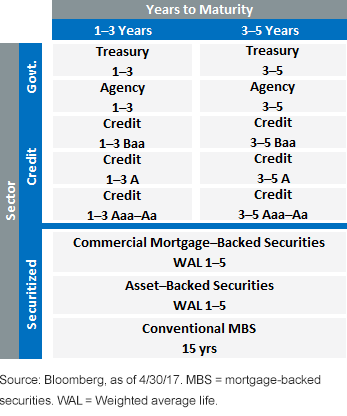Several years ago, WisdomTree helped Barclays develop a strategy that relied on the same investable universe as the Bloomberg Barclays U.S. Aggregate Index (Agg) but sought to boost yield in a risk-efficient way. The rationale of this approach was to enhance income (and expected returns) while broadly maintaining comparable levels of risk. Since we launched our exchange-traded fund (ETF) on the index, this rules-based approach has outperformed the Agg by 93 basis points (bps) per year with comparable volatility.1 In version 2.0, we’ve taken a similar framework, but limited exposures to bonds with one to five years to maturity, resulting in a strategy with significantly less interest rate risk. Below, we discuss the construction of the Bloomberg Barclays U.S. Short Aggregate Enhanced Yield Index (Short Agg Enhanced Yield) and why we feel this strategy can be an attractive option at the core of investor portfolios.
Step 1: Divide into Buckets
In the first step, the one-to-five-year portion of the Agg is separated into 13 buckets across sector, maturity, and credit quality. While each component retains a reasonable size for investability and liquidity purposes, each bucket presents unique opportunities for risk and reward.
13 Buckets across Sector, Quality, and Maturity

Step 2: Screen Securities and Apply Constraints
Next, a series of constraints are applied in order to limit risk and turnover. Compared to the Short Agg Composite, the index is allowed to be .5 years longer in duration but must keep sector differences to less than 30%. To ensure volatility remains similar, the index optimizer limits tracking error volatility to 17.5 bps per month.2
Index Characteristics Contrasted
From the perspective of investors who bench to the Agg, this process effectively cuts their interest rate risk in half (3.05 years vs. 5.96 years), while reducing income by approximately 37 bps to 2.16%.3 Assuming all other factors remain constant, interest rates would only need to rise by approximately 12 bps in order to break even on this trade. Given our defensive positioning on rates, we believe this strategy could be a prudent step, with rates actually lower year-to-date.







